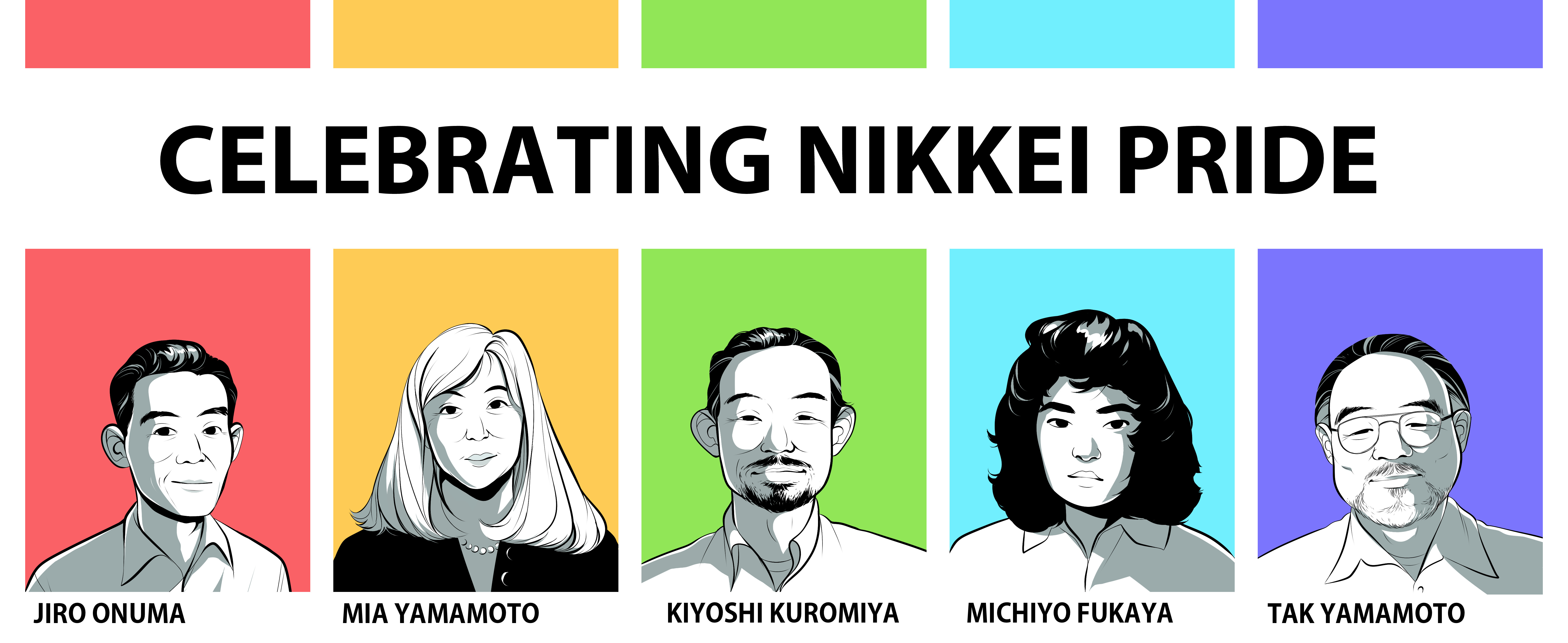June 17, 2020
As we uplift the achievements and ongoing struggles of LGBTQ communities this Pride season—which, friendly reminder, exists because Black trans women rioted against police violence—we want to highlight the stories of the queer ancestors within our own Japanese American community. Despite the often deliberate erasure of their contributions to our history, and the underrepresentation of queer and trans voices in archives (including our own), we know that LGBTQ history is Japanese American history.
So with that in mind, here are five queer Nikkei ancestors we think everyone should know about:
Jiro Onuma
“a gay dandy bachelor”
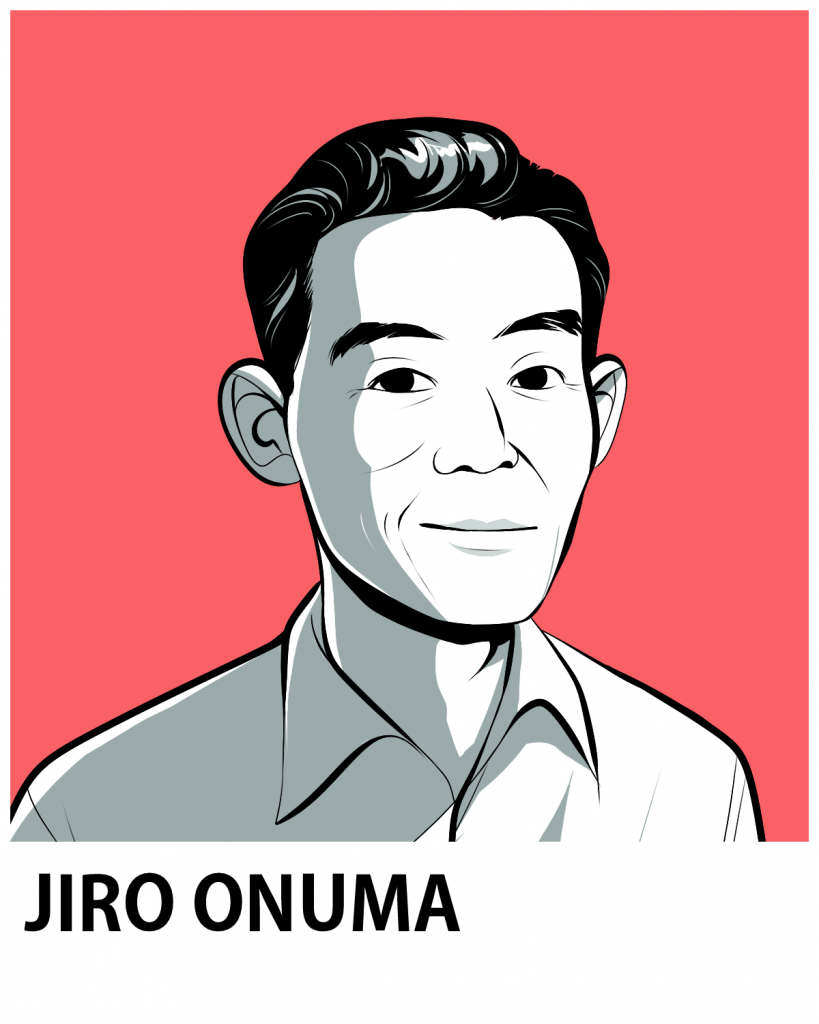
Jiro Onuma was an Issei born in Iwate on February 2, 1904. He immigrated to the U.S. at age 19 and remained in the San Francisco area for most of his adult life. By 1932, Onuma was working as a laundry machine presser in the present-day Tenderloin district of San Francisco, where he enjoyed taking studio portraits and casual photos with his Japanese American male friends and lovers. He was also an avid collector of homoerotic ephemera and magazines—like a prized postcard featuring a matador with a bronze penis that could be detached and used as a necktie clip.
In 1942, Onuma was forcibly removed first to the Tanforan Assembly Center and then to the Topaz concentration camp. His collection of photographs and memorabilia—which has since been preserved at the Gay, Lesbian, Bisexual, Transgender Historical Society—contains three photos from his time in Topaz: a group portrait with his fellow mess hall workers; a portrait of Onuma and his boyfriend Ronald, taken shortly before Ronald was transferred to Tule Lake as a “no-no boy”; and a photo of Ronald and two friends posing in front of a guard tower in Tule Lake. The wartime pictures are unique in that they are quite possibly the only known photos of adult gay Issei in the camps.
Upon his release from Topaz, Onuma worked a series of menial jobs in Salt Lake City, Denver, and other cities, before moving back to San Francisco’s Japantown in 1951. He became a naturalized citizen in August 1956, and spent much of his later life traveling extensively in Asia and Latin America.
Sadly, Onuma died alone on June 27, 1990, at the age of 86. His body was found by a friend, Edward Mycue, who donated his photo albums and other materials to the GLBT Historical Society. While he wasn’t recognized as a prominent figure in Japanese American or LGBTQ history while he was alive, Onuma’s life and what he left behind are an important testament to the very real, though often erased, intersections between those two histories—and the experiences of those who embodied it.
Adapted from Tina Takemoto’s Densho Encyclopedia article on Jiro Onuma. Read more here.
Mia Yamamoto
“Nothing good happens without all of us doing it together.”
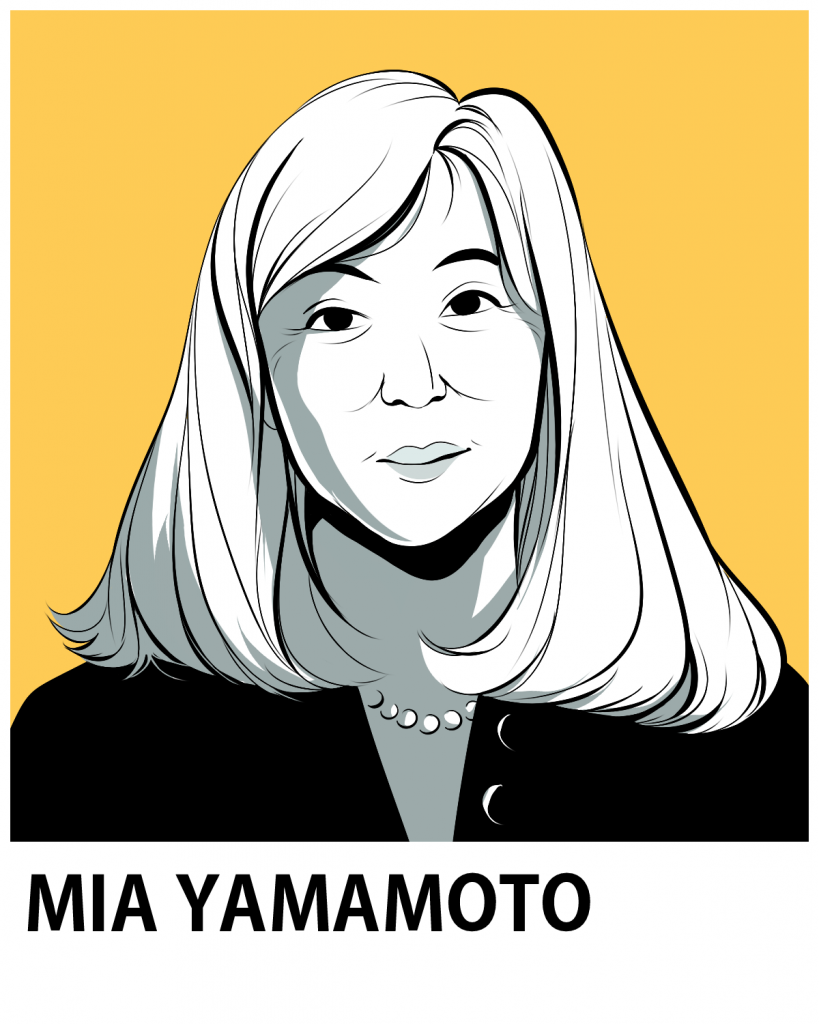
Mia Yamamoto was, in her own words, “born doing time.” She spent the first years of her life incarcerated in Poston with her family, eventually resettling in East Los Angeles after the war. She knew at an early age that the gender she’d been assigned at birth didn’t align with her true identity—but she also felt pressure to hide her real gender identity, and it wasn’t until many years later that she would finally feel ready to transition.
After high school, Mia pursued a law career, following in her father’s footsteps. She graduated from Cal State LA in 1966, and spent two years in Vietnam before returning to California to attend law school at UCLA. Her time as a soldier in the Vietnam War radicalized her. She’d later describe the military culture and wartime atrocities she witnessed there as “the absolute most extreme of male toxicity.” She became active in the anti-war movement—joining other Sansei who protested the war from a decidedly Asian American perspective—and co-founded the Asian Pacific American Law Students Association to push for ethnic studies courses and better resources for students and faculty of color.
After graduating from UCLA in 1971, Mia worked first as a poverty lawyer and then as a public defender. For over a decade, she fought for queer and trans sex workers, young people experiencing homelessness, and other vulnerable people caught up in the criminal justice system—before leaving to form her own private practice specializing in supporting people facing death penalty cases.
In 2003, Mia made the decision to publicly transition and, at age 60, became the first openly transgender lawyer in California history. She still operates her practice as a criminal defense attorney today, and remains as deeply committed to fighting for the rights and safety of all people as ever.
Kiyoshi Kuromiya
“Homosexuals have burst their chains and abandoned their closets. We came battle-scarred and angry to topple your sexist, racist, hateful society.”

LGBTQ rights activist Kiyoshi Kuromiya was born in Heart Mountain in 1943 and grew up in the Los Angeles suburb of Monrovia, where his family resettled after the war. He learned early on that to protect his physical safety he would have to hide his sexual identity—a lesson that was crystalized at age 11, when he was arrested after being caught with an older boy in a public park. He was sentenced to three nights in juvenile detention, and forced to undergo conversion therapy from a “specialist” who promised to turn him into “a real man.”
Kiyoshi’s life as an activist began to take shape in Philadelphia, as a student at the University of Pennsylvania. He was among the forty-some gay and lesbian picketers who gathered outside Independence Hall on July 4, 1965 for what is widely considered the first organized LGBTQ rights demonstration in the country: the first of several “Annual Reminders” meant to remind the American people that queer citizens were denied the “unalienable” rights to life, liberty, and pursuit of happiness that many straight and cisgender Americans took for granted.
Kiyoshi was also active in the civil rights and anti-war movements, participating in sit-ins, the March on Washington, the March on Montgomery, organizing anti-war demonstrations and literature, and even caring for the children of Martin Luther King Jr. in the weeks following Dr. King’s 1968 assassination.
But Kiyoshi is perhaps best known for his pioneering work for gay liberation, and as an AIDS activist in particular. He co-founded the Philadelphia chapter of the Gay Liberation Front soon after the Stonewall Riot, served as an openly gay delegate to the 1970 Black Panther Party Convention that endorsed the gay liberation struggle, was an integral member of ACT UP Philadelphia, and provided free internet access and comprehensive treatment information to thousands of people living with HIV through the Critical Path Project. He died on May 9, 2000, due to complications from AIDS, after a lifetime of empowering others and fighting injustice.
Michiyo Fukaya
“I will not go under; I will not give in”
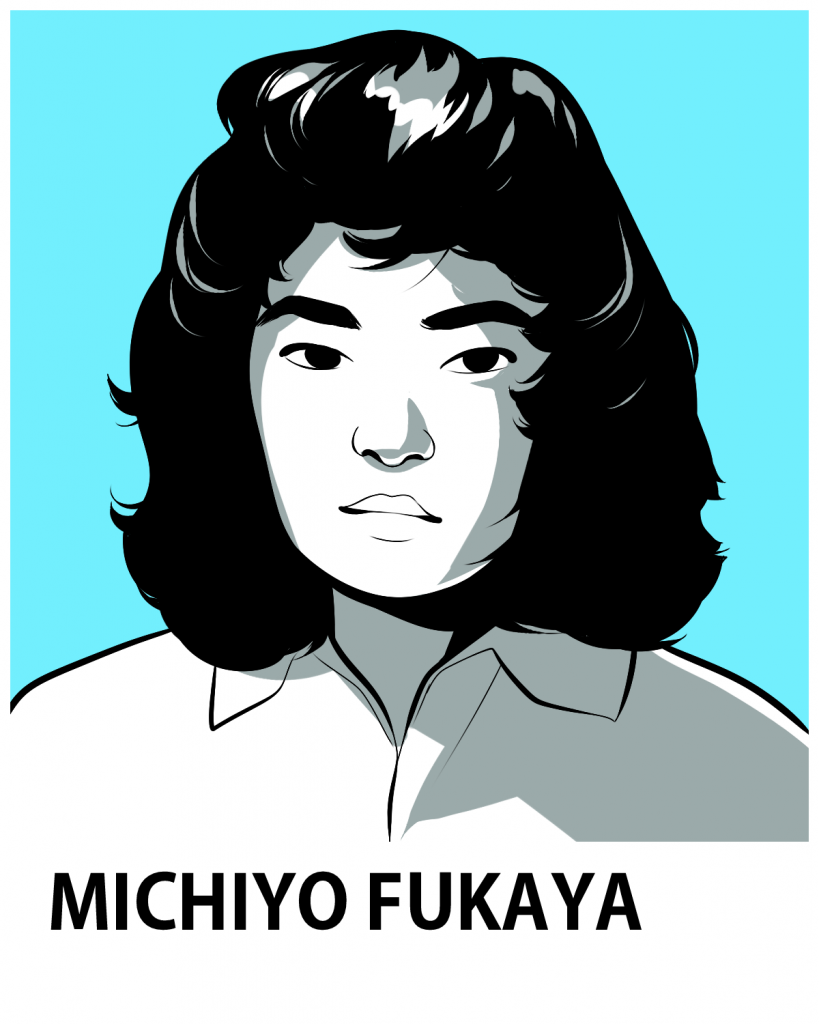
Michiyo Fukaya was a poet and writer, born on April 25, 1953 to a Japanese woman and a white American soldier. (Given the name Margaret Cornell at birth, she later took her mother’s maiden name to reclaim her Nikkei identity and reject her abusive father.) Her parents left Japan and moved the family to Vermont in 1956. Her mother died of cancer just two years later, and Fukaya spent the rest of her childhood in an emotionally and sexually abusive household where she was isolated from her Japanese heritage and subjected to racial harassment from teachers, classmates, and her white family members.
Fukaya left home to attend the University of Massachusetts, Amherst and graduated with a degree in English literature in 1975. It was there that she began to build connections with other writers and Asian Americans—although she’d later describe feeling a sense of alienation even in these kindred spaces, perceived as “too white” by Asian Americans and “too Asian” by whites. After graduation, Fukaya struggled to find work and stable housing as a young queer woman of color. She gave birth to her daughter, Mayumi, while living in a shelter for pregnant women and girls, and checked into a Vermont hospital for mental health treatment eleven months later.
Although Fukaya continued to struggle with her mental health and the strains—economic and otherwise—of being a single mother, she was also a prolific writer and fierce activist. She wrote poems and letters confronting rape and sexual violence; delivered speeches calling out white lesbians and straight Asian Americans for erasing the experiences and contributions of queer people of color; performed at open mics and marches; self-published a chapbook called Lesbian Lyrics in 1981; and helped organize Vermont’s gay and lesbian pride parade. Her historic speech given at the steps of the Washington Monument in 1979, “Living in Asian America,” was one of the first public statements to broadcast an Asian American lesbian voice to the world.
Michiyo Fukaya died by suicide on July 9, 1987, at the age of 34. Her work, and her life, have received tragically little attention in the decades since, but her “songs of resistance” have nevertheless survived and found their way to subsequent generations through the collection of her writings, There Is a Fire Burning, It Is in Me. Like many queer Asian American women before and after her, she was underestimated and undervalued for much of her life—but her legacy is proof that queer Asian American women are fully capable of building their own power, with or without mainstream approval.
Tak Yamamoto
“I am not asking for special rights. I am asking for equal rights.”
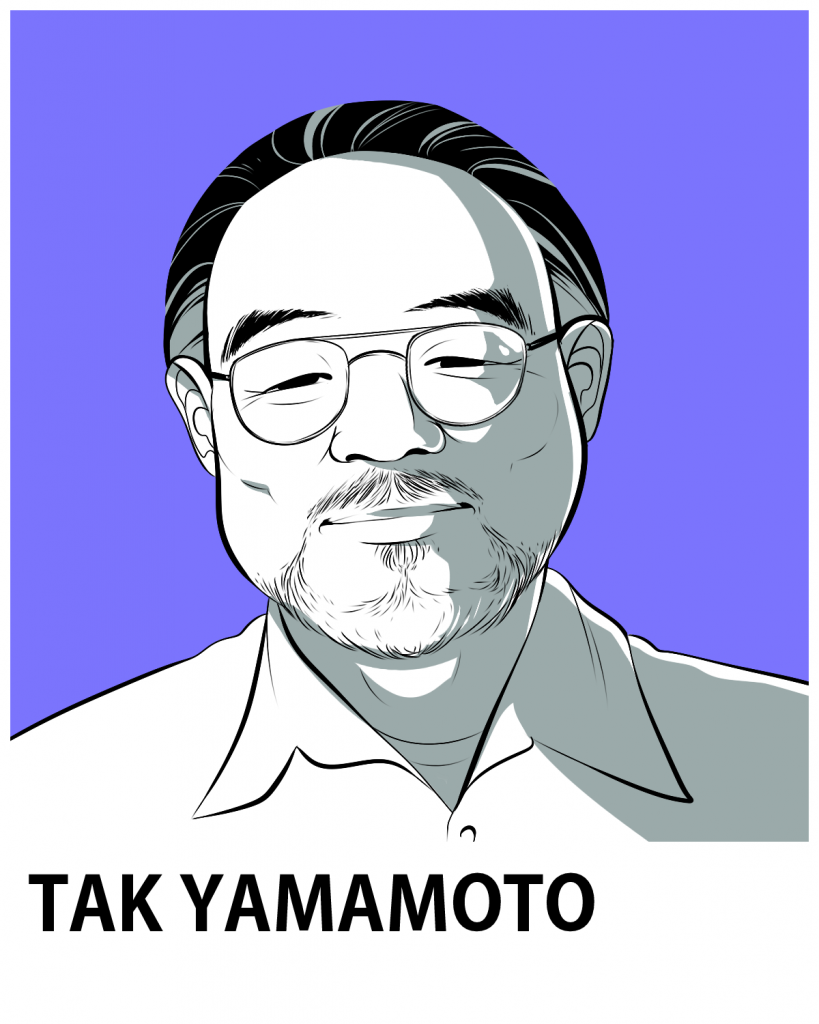
Takenori “Tak” Yamamoto was the first openly gay president of any chapter of the JACL and a longtime leader of the Manzanar Committee. He was three years old when Japan bombed Pearl Harbor, and he and his family were removed to Poston for the next three years, returning to Los Angeles after the war. Tak joined the Air Force after graduating from high school, and came out to his family while still in the service. “I had to look up the word ‘homosexual’ in the Japanese dictionary,” he recalled in a Densho interview decades later.
He joined the Manzanar Committee in the 1970s and quickly became an active member, helping to organize the annual Manzanar Pilgrimage from year to year.
In 1980, Tak co-founded Asian Pacific Lesbian & Gays, the first formal organization created to meet the specific needs of queer Asian Americans and Pacific Islanders in the U.S. “A lot of hakujin types had a problem with that,” he said. “They thought, ‘Oh, no, can’t have this.’ And then my being outspoken, I said, ‘Well, then get the hell out. We don’t need you. We need to form for ourselves.’ And so that’s how it came about.”
Tak became the first openly gay JACL president when he was appointed as the head of the San Fernando Valley chapter. He was instrumental in pushing the National JACL to pass a resolution supporting same-sex marriage at their 1994 convention.
Tak passed away on November 9, 2012, survived by his longtime partner Karl Fish and remembered by all who knew him as a courageous leader who opened doors for the next generation of LGBTQ kids to take up space and make change within their community.
—
By Nina Wallace, Densho Communications Coordinator
All artwork by Kiku Hughes. Kiku is a comics artist living and working in the Seattle area. Her work has been featured in “Beyond: A Queer Sci-Fi and Fantasy Comic Anthology”, “Elements: Comic Anthology by Creators of Color” and Short Box Comics Collection. Her first graphic novel, Displacement, about a Japanese American teenager pulled back in time to witness her grandmother’s incarceration during WWII, is forthcoming from First Second Books. Funding for Kiku’s work was generously provided by a grant from the Seattle Office of Arts & Culture.
